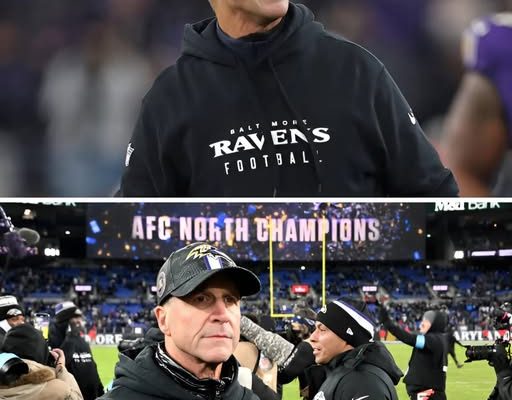Baltimore Ravens head coach John Harbaugh has officially signaled a major shift in the Ravens’ offensive approach following recent roster cuts, particularly as they pertain to quarterback Lamar Jackson’s evolving role. In the aftermath of trimming down the roster—including the release of Malik Cunningham—Harbaugh confirmed the team is embracing a new offensive identity centered around empowering Jackson more than ever before.
Once known for its physical, ground‑and‑pound roots under former coordinator Greg Roman, the Ravens’ offense has steadily morphed into a versatile, quarterback‑driven machine under Todd Monken and Lamar Jackson. Harbaugh emphasized that the latest changes are not mere tweaks, but represent a continuation and amplification of their vision: to put Jackson more in control at the line of scrimmage and in the architect’s seat.
Harbaugh made clear that Jackson will now have expanded responsibilities pre-snap. He said, “Lamar is going to be very responsible for making decisions at the line and I love the way it’s being taught right now” (SI). In practice this means Jackson will have greater authority to call audibles, switch run or pass protections, and adjust routes on the fly—essentially giving him more of the “keys to the Ferrari” of the offense .
This change follows weeks of offseason reflection, coming on the heels of Jackson’s own push for deeper involvement. After the Ravens’ AFC Championship Game defeat, Jackson requested greater latitude in reading defensive fronts and redirecting the offense accordingly. Harbaugh responded in lockstep, promising to build a system in which Jackson co‑designs as much as he drives .
John Harbaugh sees the offense entering version “3.0”—a refined iteration blending the skill sets of Jackson, newly acquired talents, and a heavier personnel grouping. With the signings of Derrick Henry and DeAndre Hopkins, and returning pieces like Rashod Bateman, Zay Flowers, Mark Andrews, and Isaiah Likely, Harbaugh says the offense will be more “positionless” and adaptable than ever .
Roster cuts have freed up space for formation versatility. For example, with Malik Cunningham released after attempts to convert him from quarterback to receiver, the Ravens have cleared room for more traditional receivers and tight ends—strengthening packages heavy on size and movement Harbaugh indicated that heavier personnel sets—using two or even three tight ends—will now feature more prominently. That combination of mass, multiple tight ends, and Jackson’s mobility creates mismatches across offensive fronts .
On the ground, Jackson will continue to be a rushing threat, but Harbaugh says he won’t lean into quarterback runs as heavily as before. The goal is subtler: use bootlegs, scrambles, and quick RPOs to keep defenders unbalanced without exposing Jackson to unnecessary physical tolls. Meanwhile majority carries will belong to Derrick Henry, whose presence naturally reshapes run–pass balance (Fox Sports, .
Harbaugh reiterated that while RPOs remain in the mix, they will not define the scheme. “RPOs will be part of what we’re doing … but they’re not going to be the main part of what we’re doing,” he explained, underscoring that the offense must stay diverse to maximize Jackson’s intelligence and versatility .
From Jackson’s perspective, this heightened role is the next step in transformation. As Harbaugh noted, “If Lamar’s the driver, he has to be involved in the setup of the car even more”—a nod to Jackson’s growing influence in personnel decisions and schematic tweaks (NBC Sports).
Jackson, teammates, and media alike have already observed the difference. Reporters highlighted how Jackson has become more vocal in camp, relaying defensive tendencies and calling protections, while second-year players like Isaiah Likely and Nelson Agholor commented on Jackson’s increased command of the offense during training periods .
The front office has backed this strategy with key acquisitions: veteran DeAndre Hopkins joined for a one‑year deal, giving Jackson a proven deep threat and helping balance the receiving corps alongside Zay Flowers and Bateman . Derrick Henry reunites with Hopkins from their time in Tennessee, creating backfield options that demand attention and clear space for Jackson to operate in open field .
John Harbaugh’s message is clear: the Ravens are not abandoning Jackson’s dual-threat game—rather, they’re shaping an offense that uses his vision, mobility, and decision‑making as the pivot for everything else. The roster cuts are part of a deep rebuild—not a reset—meant to give Jackson a leaner but more powerful support system.
Monken’s offense enters its third season of development. Harbaugh calls it “iteration 3.0,” and believes they’re building the most effective version yet. “We’re kind of in every world offensively,” Harbaugh said. “It’s not easy to do that, but we can do that because our quarterback is capable of living in all of those different offensive worlds” .
In practice, we’re likely to see quicker tempo, more pre-snap motion, and greater personnel plurality. Jackson’s audibles and cadence manipulation will be key tools for drawing defenses offsides or forcing hesitation. Harbaugh emphasized that enhancing Jackson’s cadence remains an offseason focus—a way to give the team an edge in timing and execution (
As training camp progresses and preseason games unfold, the Ravens’ roster decisions will continue to reinforce this offensive philosophy. Cuts like Cunningham’s and the decision to lean into tight-end heavy packages are deliberate moves to create flexibility and allow Jackson’s leadership to thrive.
Ultimately, Harbaugh’s embrace of Jackson’s expanded role reflects both trust and urgency. The Ravens know they’ve built a potent core; now the challenge is deploying it with creativity and adaptability. Harbaugh sees Jackson not just as a player but as an architect—one who helps “drive the car” and shape how it’s built. With their offensive evolution after roster cuts, Baltimore is betting that their MVP‑caliber quarterback can now deliver at an even higher level.
As the season approaches, all eyes will be on how this offense executes. If Harbaugh’s vision holds true, Lamar Jackson won’t just run plays—he’ll be building them, reshaping defenses, and guiding a Ravens offense ready for its next chapter.



